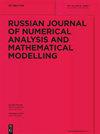用相关随机算法求解随机介质中伽马辐射传递问题的效率
IF 0.6
4区 数学
Q4 MATHEMATICS, APPLIED
Russian Journal of Numerical Analysis and Mathematical Modelling
Pub Date : 2022-08-01
DOI:10.1515/rnam-2022-0020
引用次数: 0
摘要
为了解决辐射平衡、光学探测和层析成像等问题,可能需要考虑随机非均匀介质中辐射的多次散射。在真实的辐射模型中,为此目的,通过添加人工的“三角洲散射”事件,基于光密度场的对准,使用了数值统计的“主截面法”(MCM, delta- woodcock跟踪)。然而,对于随机介质密度,随着标准镶嵌模型的相关尺度(相关半径L)的减小,相应的平均问题解的无偏估计的计算量会无限增加。之前,我们构建了MCM随机化,提供了所需函数的渐近(对于L→0)无偏估计,其中物理衰减系数的值在条件L > L下随机选择在粒子自由路径L的末端,否则物理衰减系数的值与粒子的起点相同(CR算法)。在更精确的函数相关随机化算法(FCR算法)中,系数保持不变,其概率由相关函数决定。这些相关的随机算法被用于均质物质(水)和“空”球的泊松系综的混合物。在本文中,我们构造了相关的随机化算法,用于解决通过含有水的“厚”层和“空”层的泊松系综的传输问题。对伽玛辐射通过含有“空”层或球的泊松系综的“厚”水层传输问题,用精确直接模拟(MCM)和近似算法(CR, FCR)得到的结果进行了详细的比较分析。本文章由计算机程序翻译,如有差异,请以英文原文为准。
On the efficiency of using correlative randomized algorithms for solving problems of gamma radiation transfer in stochastic medium
Abstract To solve problems of radiation balance, optical sounding, and tomography, it may be necessary to take into account multiple scattering of radiation in a stochastically inhomogeneous medium. In real radiation models, for this purpose, the numerical-statistical ‘majorant cross-section method’ (MCM, delta-Woodcock tracking) is used based on the alignment of the optical density field by adding an artificial ‘delta scattering’ event. However, the computation cost of the corresponding unbiased estimate of the averaged problem solution infinitely increases as the correlation scale (correlation radius L) of standard mosaic models for a random medium density decreases. Previously, we constructed the MCM randomization providing asymptotically (for L → 0) unbiased estimates of the required functionals, in which the value of the physical attenuation coefficient is randomly chosen at the end of the particle free path l under condition l > L. Otherwise the value of the physical attenuation coefficient is the same as at the starting point of the particle (CR algorithm). In a more accurate functional correlative randomized algorithm (FCR algorithm), the coefficient remains the same with a probability determined by the correlation function. These correlative randomized algorithms were implemented for a mixture of homogeneous substance (water) and a Poisson ensemble of ‘empty’ balls. In the present paper, we construct correlative randomized algorithms for problems related to transfer through a ‘thick’ layer containing a water and a Poisson ensemble of ‘empty’ layers. A detailed comparative analysis of the results obtained by exact direct simulation (MCM) and approximate algorithms (CR, FCR) for the problems of gamma radiation transfer through a ‘thick’ water layer containing a Poisson ensemble of ‘empty’ layers or balls is presented.
求助全文
通过发布文献求助,成功后即可免费获取论文全文。
去求助
来源期刊
CiteScore
1.40
自引率
16.70%
发文量
31
审稿时长
>12 weeks
期刊介绍:
The Russian Journal of Numerical Analysis and Mathematical Modelling, published bimonthly, provides English translations of selected new original Russian papers on the theoretical aspects of numerical analysis and the application of mathematical methods to simulation and modelling. The editorial board, consisting of the most prominent Russian scientists in numerical analysis and mathematical modelling, selects papers on the basis of their high scientific standard, innovative approach and topical interest.
Topics:
-numerical analysis-
numerical linear algebra-
finite element methods for PDEs-
iterative methods-
Monte-Carlo methods-
mathematical modelling and numerical simulation in geophysical hydrodynamics, immunology and medicine, fluid mechanics and electrodynamics, geosciences.

 求助内容:
求助内容: 应助结果提醒方式:
应助结果提醒方式:


